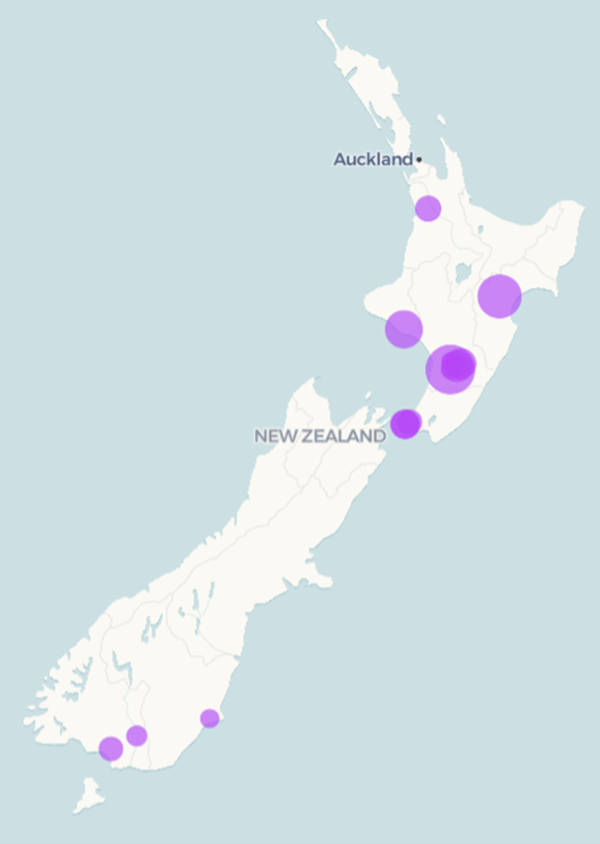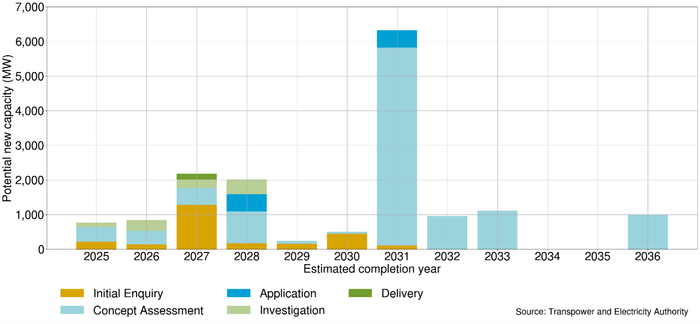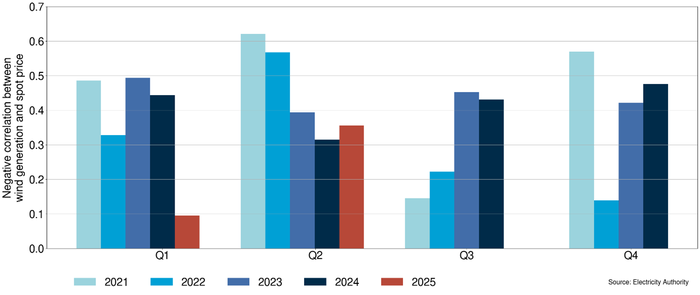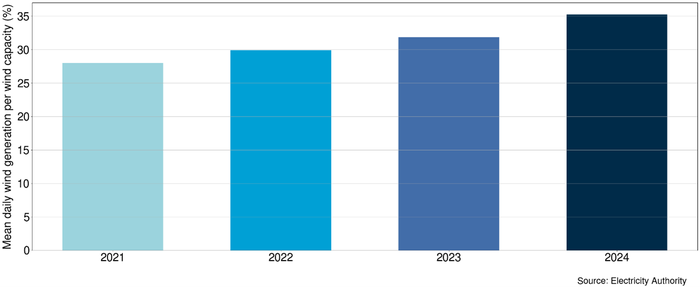Eye on electricity
Wind will play a larger role in electricity generation
- Generation
- Innovation
In Aotearoa New Zealand, wind generation is growing. Wind farms currently make up around 11% of our total electricity generation capacity, the majority of which is in the North Island (Figure 1). In 2024, 9.4% of all electricity was generated by wind, an increase of 1.7% compared to 2023. This article examines the impact of growing wind generation on our electricity system.

New wind generation is on the horizon
The Authority can estimate how much new generation may be built in the upcoming years using Transpower’s investment pipeline data. This data is gathered when companies ask Transpower about connecting future generation to the electricity grid. Of this potential new generation, wind generation (both onshore and offshore) has the largest share of capacity, with solar following close behind.
Potential onshore wind projects make up 21.5% of the possible new capacity, while offshore makes up 23.7% (Figure 2). Though not every project in the pipeline is guaranteed to reach completion, the data clearly shows us that intermittent wind and solar generation will play a large role in Aotearoa’s energy future.

When wind generation is high the wholesale electricity price is often lower
An advantage of wind generation is that there is no fuel cost. However, there is no ability to store fuel for later use (without using grid scale batteries), so wind generators can only generate electricity when there is enough wind to do so.
Wind generation is offered into the wholesale electricity market at a low price to ensure the System Operator chooses to dispatch it. This often influences wholesale electricity spot prices in the short term. When wind generation is high, spot prices are often lower, and vice versa. Figure 3 shows the average strength of this relationship for quarters over the years 2021-25.

In Quarter 1 of 2025 this wind generation and spot price relationship was the weakest it has been in recent years. This was due to the lowest hydro inflows for Quarter 1 on record; the rapid drop in hydro storage resulted in spot prices increasing throughout the quarter. This overpowered the short-term relationship between wind and spot price. In Quarter 2 of 2025, hydro storage did not fluctuate significantly and the relationship between wind and price was stronger.
Wind generation is highly variable
A downside of wind generation is that it is highly variable. How much wind generation, or if there will be any wind generation at all, is dependent on Aotearoa’s rapidly changing weather patterns.
On average, wind generation shifts up or down by 14% of total wind capacity on a day-to-day basis. However there can be much larger swings. In recent years, the largest change in wind generation from one day to the next was 58% of capacity. This occurred when daily average wind generation went from 169MW on 28 January 2025 to 855MW the next day, then back to 169MW on 30 January. The largest wind generation change from one half hour to the next was 35% of capacity. As wind capacity increases, the impact of these swings will also increase.
However, when more wind farms are built in diverse locations, the overall variability of wind generation decreases. While the wind may be low in one region, it could be high in another.
Looking at the last four years of wind generation, each year has seen an increase in average wind generation, even when the increase in capacity is accounted for (Figure 4). These increases are likely due to new wind farms slightly increasing diversity and reducing overall variability. However, it is likely that this trend will eventually level out because Aotearoa is geographically small and has limited wind variability across the country.

How the Authority is supporting wind generation with the new hybrid forecasting arrangement
As discussed in a previous Eye on electricity article, effectively forecasting wind generation is critical to managing a highly renewable power system. The System Operator must have a reasonable forecast of wind generation.
As more wind generation is built, the risk created by an unforeseen drop in wind increases with wind capacity. Unforeseen jumps in wind generation can also be problematic because other generators who were expecting to generate a certain amount of energy at a certain price may find themselves unexpectedly not being dispatched or being dispatched at a price that is not economical for their generation type.
On 31 July 2025, the hybrid forecasting arrangement came into effect. The Authority has awarded to DNV Services a contract to provide centralised wind and solar forecasting services. This will provide a centrally procured forecast for each wind and solar generation site. As it is a hybrid arrangement, intermittent generators will be able to use their own providers, so long as they can demonstrate that the provider’s forecasts meet the required performance standards.
The Authority will monitor the performance of the central forecast provider, and all alternative providers, on a regular basis, and have monthly and quarterly internal meetings to discuss their performance and make any recommendations if needed. Wind forecast accuracy will continue to be discussed in our regular trading conduct reports.
Related News
How marginal electricity spot pricing reflects cost
In the New Zealand wholesale electricity market, the price paid to dispatched generators is the nodal ‘spot price’, which is priced to reflect the ‘margina…
New generation projects flowing through the investment pipeline
New electricity generation projects are expected to significantly boost New Zealand’s energy system over the next two years. As at October 2025, there were 28…
Future System Operation project - update and next steps
Following consideration of feedback, engagement with submitters and additional analysis, the Electricity Authority Te Mana Hiko has revised the next steps …